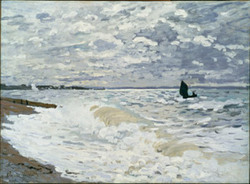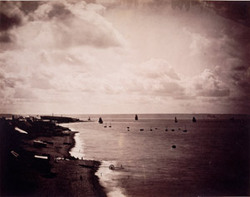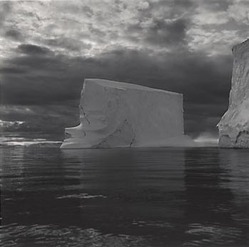 How did the advent of the camera, and specifically the development of fine art photography, spur the new approach to painting known now as Impressionism? Not just the camera, of course — it was coupled with other social, artistic, technological, and commercial changes that began along the Normandy coast in 1850s France. Especially the development of tourism.
How did the advent of the camera, and specifically the development of fine art photography, spur the new approach to painting known now as Impressionism? Not just the camera, of course — it was coupled with other social, artistic, technological, and commercial changes that began along the Normandy coast in 1850s France. Especially the development of tourism.
 That is the point of what sounds like a great exhibit organized by the University of Michigan Museum of Art. The Lens of Impressionism: Photography and Painting Along the Normandy Coast, 1850-1874 closed on Jan. 3, but is now moving to the Dallas Museum of Art, where it opens on Feb. 21 and runs ’til May 22. Sounds good — and there’s more: Dallas is adding its own touch.
That is the point of what sounds like a great exhibit organized by the University of Michigan Museum of Art. The Lens of Impressionism: Photography and Painting Along the Normandy Coast, 1850-1874 closed on Jan. 3, but is now moving to the Dallas Museum of Art, where it opens on Feb. 21 and runs ’til May 22. Sounds good — and there’s more: Dallas is adding its own touch.
In the show organized by Michigan, Dallas will display about 100 works by the likes of Courbet, Degas, Monet, Le Gray, Manet, Whistler and Boudin. The twin images here are by Monet — The Sea At Le Harvre, 1868 — and by Le Gray — The Beach at Sainte-Adresse, View  of the Cliffs (Plage de Sainte-Adresse, vue de la falaise), 1856. The Michigan museum has more examples here (as well as a video about the show).
of the Cliffs (Plage de Sainte-Adresse, vue de la falaise), 1856. The Michigan museum has more examples here (as well as a video about the show).
Then, Dallas is doing something smart: On April 25, it will open Coastlines: Images of Land and Sea, an exhibit drawn from its collections that displays how artists throughout the past century–from Hopper to De Kooning to Richter to Opie–have depicted land and seascapes, from Miami Beach to Maine, North Africa to Nice, into their work. That’s Lynn Davis’s Iceberg #25 (Disko Bay-Iceland), 2000, at left. (Couldn’t find a twin.)
You can read more about Coastlines here.
Obviously, I haven’t seen either exhibit, but I love the pairing, and the idea that visitors will see 160 years of art in two distinct but related shows.
